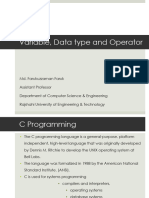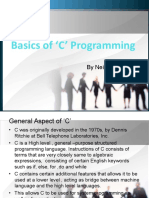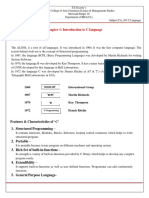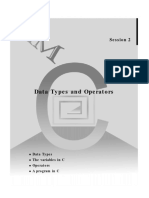0 ratings0% found this document useful (0 votes)
99 views31 pagesInternship Report C and C++
Internship papers of c and c++
Uploaded by
raj929504Copyright
© © All Rights Reserved
We take content rights seriously. If you suspect this is your content, claim it here.
Available Formats
Download as PDF or read online on Scribd
0 ratings0% found this document useful (0 votes)
99 views31 pagesInternship Report C and C++
Internship papers of c and c++
Uploaded by
raj929504Copyright
© © All Rights Reserved
We take content rights seriously. If you suspect this is your content, claim it here.
Available Formats
Download as PDF or read online on Scribd
You are on page 1/ 31
ACKNOWLEDGEMENT
| have taken efforts in this industrial training. However, it would not have been possible
without the kind support and help of many individuals and organizations, I would like to
extend my sincere thanks to all of them.
A Special thanks to computer science department for giving me the opportunity to pursue
my industrial training in the institute.
I would like to express my special gratitude and thanks to industry persons for giving us
such attention and time.
NAME. — :-SAHIL KUMAR
ROLL NO. :- 22EE64LE
ABSTRACT
lam a student of Government Engineering College, bhojpur and studying
in EE 3" semester. As a part of our degree we have undergone in a training
process for 8 weeks.
Present is the age of computers and technologies. Practical knowledge has its
own importance. Without practical knowledge one cannot be specialized in
one’s field. We have automated the practical knowledge of institutes and
their working in the project.
CONTENTS
S.No Content Page No.
1 Brief history of C 5
2 Data types in C 6
3 Operations in C 9
4 Types of loop 11
5 C-Functions 12
6 Pointers
7 File Handling in C 14
8 OOP-Introduction 16
9 Constructor and 18
Destructor
10 Inheritance 23
11 Polymorphism 26
12 Exception Handling in 29
C++
13 Templates in C++ 30
14 File Handling in C++ 31
Brief History of C Programming Language
9C is a general-purpose programming language which features economy of
expression, modern control flow and data structures, and a rich set of
operators. C is not a "very high level" language, nor a "big" one, and is not
specialized to any particular area of application. But its absence of
restrictions and its generality make it more convenient and effective for
many tasks than supposedly more powerful languages.
> The history of C programming language is quite interesting. C was originally
designed for and implemented on the UNIX operating system on the DEC
PDP-Il, by Dennis Ritchie. C is the result of a development process that
started with an older language called BCPL. BCPL was developed by Martin
Richards, and it influenced a language called B, which was invented by Ken
Thompson. B led to the development of C in the 1970s.
>For many years, the de facto standard for C was the version supplied with
the UNIX operating system. In the summer of 1983 a committee was
established to create an ANSI (American National Standards Institute)
standard that would define the C language. The standardization process
took six years (much longer than anyone reasonably expected).
‘The ANSI C standard was finally adopted in December 1989
Uy
u
u
woe 5
Constants and Variables in C language
Constant
> As the name suggests the name constants is given to such variables or values in C
programming language which cannot be modified once they are defined. They are
fixed values in a program. There can be any types of constants like integer, float, octal,
hexadecimal, character constants etc. Every constant has some range. The integers
that are too big to fit into an int will be taken as a long. Now there are various ranges
that differ from unsigned to signed bits. Under the signed bit, the range of an int varies.
from -128 to +127 and under the unsigned bit, int varies from 0 to 255.
Variables in c
In programming, a variable is a container (storage area) to hold data.
To indicate the storage area, each variable should be given a unique name (identifier).
Variable names are just the symbolic representation of a memory location
Data types in C Lanquage
> Data types specify how we enter data into our programs and what type of data we enter. C language
has some predefined set of data types to handle various kinds of data that we can use
in our program. These datatypes have different storage capacities.
C language supports 2 different type of data types:
1. Primary data types:
These are fundamental data types in C namely integer(int), floating point(float),
character(chan) and void.
Ld
Derived data types:
Derived data types are nothing but primary datatypes but a little twisted or grouped
together like array, stucture, union and pointer. These are discussed in details later.
Data type determines the type of data a variable will hold. If a variable x is declared as int.
it means x can hold only integer values. Every variable which is used in the program must be
deciared as what data-type itis.
Integer type:
> Integers are used to store whole numbers.
Size and range of Integer type on 16-bit machi
Type Sizo(bytes) Range
intor cigned int 2 32,768 10 92767
unsigned int 2 01065595
‘short int or signed short int 1 +128 10 127
unsigned short int 1 00255
Jong into signed long int 4 -2,A47 483,648 to 2,147 483,647
unsigned long int 4 0 to 4,294,967,205
Floating point type
Floating types are used to store real numbers.
Size and range of Integer type on 16-bit machine
Type Size(bytes) Range
Float 4 346-35 10 3.46435
Double 8 1.7308 t0 1.764308
Jong double 10 346-4932 to 11644932
Character type:
Character types are used to store characters value.
Size and range of Integer type on 16-bit machine
Type Size(bytes) Range
char or signed char 1 12810 127
unsigned char 1 010.255
void typi
void type means no value. This is usually used to specify the type of functions which returns nothing. We
will get acquainted to this datatype as we start leaming more advanced topics in C language, like functions,
pointers ete.
C Programming Operators
> C Arithmetic Operators
An arithmetic operator performs mathematical operations such as addition, subtraction, multiplication,
division etc on numerical values (constants and variables).
> Clncrement and Decrement Operators
programming has two operators increment ++ and decrement -- to change the value of an operand
(constant or variable) by 1.
Increment ++ increases the value by 1 whereas decrement -- decreases the value by 1. These two
operators ate unary operators, meaning they only operate on a single operand.
> C Assignment Operators
‘An assignment operator is used for assigning a value to a variable. The most common assianment operator
is=
> C Relational Operators
A relational operator checks the relationship between two operands. If the relation is true, it returns 1; if the
relation is false, it returns value 0.
> C Logical Operators
‘An expression containing logical operator retums either 0 or 1 depending upon whether expression results
true oF false. Logical operators are commonly used in decision making in C programming.
Operator Meaning Example
Logical AND. True only talloperands are ‘ite =5 and d'=2 then, expression ((¢==5) 88
aa te (@5)) equals 100.
Logical OR. True only ifeither one operand te = 5 and d =2 then, expression ((e==5) ||
fT is true (45) equals to 1
! Logical NOT. True only ifthe operand is 0
C Bitwise Operators
During computation, mathematical operations like: addition, subtraction, multiplication, civision, etc are
converted to bi-level which makes processing faster and saves power.
Bitwise operators are used in C programming to perform bit-ievel operations.
Operators Meaning of operators
& Bitwise AND
1 Bitwise OR
“ Bitwise exclusive OR
- Bitwise complement
<< Shift left
> ‘Shift right
‘Operator ‘Associativity
00> == Teft tonight
Fan (ype aire0F Right ole
T% Left right
+ Left to right
5, j<3, k=3 )
‘exp3 — increment/decrement
(Example: ++i, j-, +k)
while (condition)
{ statements; }where,
condition might be a>5, i<10
do { statements; }
while (condition);where,
condition might be a>5, i<10
Arrays a kind of data structure that can store a fixed-size sequential collection of elements of the same
type. An array is used to store a collection of data, but it is often more useful to think of an array as a
collection of variables of the same type.
a
Instead of declaring individual variables, such as number0, numbert, .... and number99, you dectare one
array variable such as numbers and use numbers[0], numbers[1], and ..., numbers[99] to represent
individual variables. A specific element in an array is accessed by an index.
All arrays consist of contiguous memory locations. The lowest address corresponds to the first element and
the highest address to the last element.
C - Functions
A function is a group of statements that together perform a task. Every C
program has at least one function, which is main(), and all the most trivial
programs can define additional functions.
You can divide up your code into separate functions. How you divide up your
code among different functions is up to you, but logically the division is such that
each function performs a specific task.
A function declaration tells the compiler about a function's name, return type,
and parameters. A function definition provides the actual body of the function.
The C standard library provides numerous built-in functions that your program
can call. For example, strcat
void main()
{
int num:
num = square(4);
print#(“%ed" pum)
}
imt square(int nt)
{
int x = nl * nt:
return(x): R
}
What are Pointers?
A pointer is a variable whose value is the address of another variable,
ie., direct address of the memory location. Like any variable or
constant, you must declare a pointer before using it to store any
variable address. The general form of a pointer variable declaration is —
type *var-name;
Here, type is the pointer's base type; it must be a valid C data type
and var-name is the name of the pointer variable. The asterisk * used
to declare a pointer is the same asterisk used for multiplication.
However, in this statement the asterisk is being used to designate a
variable as a pointer. Take a look at some of the valid pointer
declarations —
int /* pointer to an integer */
double /* pointer to a double */
float /* pointer to a float */
char /* pointer to a character */
The actual data type of the value of all pointers, whether integer, float,
character, or otherwise, is the same, a long hexadecimal number that
represents a memory address. The only difference between pointers of
different data types is the data type of the variable or constant that the
pointer points to.
address of "a" <_
_LSOe |
7 ptr — pointer name
10 address of pointer
()1o concatenate two strings, memepy() to copy one memory location to another location, and many more
functions.
A function can also be referred as a method or a sub-routine or a procedure, etc.
Basics of File Handling in C
‘So far the operations using C program are done on a prompt / terminal which is not stored
anywhere. But in the software industry, most of the programs are written to store the
information fetched from the program. One such way is to store the fetched information in a
file. Different operations that can be performed on a file are:
Creation of a new file (fopen with attributes as “a” or “at” or “w" or “w++")
Opening an existing file (fopen)
Reading from file (fscanf or fgetc)
Writing to a file (fprintf or fputs)
Moving to a specific location in a file (fseek, rewind)
Closing a file (fclose)
7. FILE *filePointer;
8.So, the file can be opened as
ON PwNVs
9. filePointer = fopen(“fileName.txt”, “w”)
opening a file
FILE * filePointer;
filePointer = fopen(“fileName.txt”, “r”);
fscanf(filePointer, "%s %s Xs %d", stri, str2, str3, year);
writing a file
FILE *filePointer ;
filePointer = fopen(“fileName.txt”, “w”);
fprintf(filePointer, "%s %s %s %d", "We", "are", "
» 2012);
“
Why C++?
+ Popular and relevant (used in nearly every application domain):
— end-user applications (Word, Excel, PowerPoint, Photoshop, Acrobat,
Quicken, games)
operating systems (Windows 9x, NTT, XP; IBM’s K42; some Apple OS X)
large-scale web servers/apps (Amazon, Google)
central database control (Israel's census bureau; Amadeus; Morgan-
Stanley financial modeling)
communications (Alcatel; Nokia; 800 telephone numbers; major
transmission nodes in Germany and France)
numerical computation / graphics (Maya)
device drivers under real-time constraints
+ Stable, compatible, scalable
C vs. C++
+ C++ is C incremented
(orig., “C with classes”)
+ C++ is more expressive
(fewer C++ source lines needed than C source lines for same program)
+ C++ is just as permissive
(anything you can do in C can also be done in C++)
+ C++ can be just as efficient
(most C++ expressions need no run-time support;
‘C++ allows you to
— manipulate bits direetly and interface with hardware without regard for safety
or ease of comprehension, BUT
hide these details behind a safe, clean, elegant interface)
+ C++ is more maintainable
(£000 tines of code ~ even brute forve, spaghetti code will work;
100,000 lines of code — need good structure, or new errors will be
introduced as quickly as old errors are removed)
What is object-oriented?
+ Encapsulation
“black box” — internal data hidden
Ge=
+ Inheritance espe
related classes share implementation
and/or interface
+ Polymorphism
ability to use a class without knowing its type
“C++ is an object-oriented language”
C+ provides mechanisms that support object-oriented style of programming
What is OOPS?
Object Oriented Programming is a programming concept that works on the principle that objects
are the most important part of your program. It allows users create the objects that they want
and then create methods to handle those objects. Manipulating these objects to get results is
the goal of Object Oriented Programming.
Object Oriented Programming popularly known as OOP, is used in a modern programming
language like Java
1) Class
2) Object
3) Inheritance
4) Polymorphism
5) Encapsulation
16
1) Class
The class is a group of similar entities. It is only an logical component and not the physical
entity. For example, if you had a class called “Expensive Cars’ it could have objects like
Mercedes, BMW, Toyota, etc. Its properties(data) can be price or speed of these cars.
While the methods may be performed with these cars are driving, reverse, braking etc.
2) Object
An object can be defined as an instance of a class, and there can be multiple instances of a
class in a program. An Object contains both the data and the function, which operates on the
data. For example - chair, bike, marker, pen, table, car, eto.
3) Inheritance
Inheritance is an OOPS concept in which one object acquires the properties and behaviors
of the parent object. It's creating a parent-child relationship between two classes. It offers
robust and natural mechanism for organizing and structure of any software.
4) Polymorphism
Polymorphism refers to the ability of a variable, object or function to take on multiple forms.
For example, in English, the verb run has a different meaning if you use it with a /aptop, a foot
race, and business. Here, we understand the meaning of run based on the other words used
along with it.The same also applied to Polymorphism.
5) Encapsulation
Encapsulation is an OOP technique of wrapping the data and code. In this OOPS concept, the
variables of a class are always hidden from other classes. It can only be accessed using the
methods of their current class. For example - in school, a student cannot exist without a class.
wv
Constructors and Destructors in C++
Constructors are special class functions which performs initialization of every object. The Compiler calls the
Constructor whenever an object is created. Constructors initialize values to object members after storage is
allocated to the object.
Whereas, Destructor on the other hand is used to destroy the class object.
While defining a contructor you must remeber that the name of constructor will be same as the name of
the class, and contructors will never have a retum type.
Constructors can be defined either inside the class definition or outside class definition using class name
and scope resolution :: operator.
Constructor Destructor
vs.
1
L
Types of Constructors in C++
Constructors are of three types:
4. Default Constructor
2. Parametrized Constructor
3. Copy COnstructor
Default Constructors
Default constructor is the constructor which doesn't take any argument. it has no parameter.
‘Syntax:
class_name(parameter1, parameter2, ...)
i
Parameterized Constructors
These are the constructors with parameter. Using this Constructor you can provide different
values to data members of different objects, by passing the appropriate values as argument.
Copy Constructors
These are special type of Constructors which takes an object as argument, and is used to
copy values of data members of one object into other object. We will study
in detail later.
Destructors in C++
Destructor is a special class function which destroys the object as soon as the scope of
object ends. The destructor is called automatically by the compiler when the object goes out
of scope. Destructor will not have any argument
The syntax for destructor is same as that for the constructor, the class name is used for the
name of destructor, with a tilde ~ sign as prefix to it.
a
References
Reference: alternate
name for an object (alias) #9t 5; int ga =
‘There is no (Now use ‘a’ as *b’)
null reference
No reference to sntba= L;
a temporary
int<6a;
Syntax confusing int* c = 6a;
Basically a const \
dereferenced pointer eet address of”
with no operations (not a reference)
Confusing syntax
int a, b; * means
+ multiplication, or
intc=a*b; .
* pointer, or
int* d = &a; + dereference pointer
i = *d;
int e = *d; & means
+ get address of, or
ints £ = a; .
+ reference
Same symbol, different meanings!
vss yy Pass by X
by pointer
value pase
\ by
void £(int-a, int* b, inte) reference
‘
// changes to a are W07 reflected outside the function
// changes to b and c AR reflected outside the function
nain()
‘
DOES int a,b, ¢: does NOT
make a copy £(a, &b, c); make acopy
Lo +f tt J
PBP and PBR are different syntax for the sante functionality
Argument passing / return
+ Pass / return by value
calls copy constructor
~ performance penalty for structs and classes (emporary objects)
+ Pass / return by reference or pointer
does not call copy constructor
pays inputs by const reference
never pass inputs by “plain” reference
void update(inté a); update(2); // error
pass outputs by pointer
int x= 1; next(x); // should not change x
int x= 1; next(éx); // may change x
— ok to return a ref, or const ref
an
C++ function mechanisms
Overloaded function names
~ Cleaner and safer
print (int);
print (float) ;
But beware
print (int); print (int#) ; print (0);
Default parameters
void print (int a, int D0, int o=0);
+ Operator overloading
Matrix operator+=(const Matrixé other) ;
+ Implicit conversion operator
operator int() const (} // converts to int
Provides convenient syntax, but potentially dangerous so use
sparingly
Namespaces
+ Namespace expresses logical grouping
+ using declaration
— Don’t use global using except for transition to
older code
— Ok in namespace for composition
— Ok in function for notational convenience
+ Namespaces are open
+ Unnamed namespaces restrict code to local
translation unit
+ Aliases (namespace ShortName = LongName; )
C++ Inheritance
Inheritance
+ Subclass derived from base class
+ Two classes should pass the “ISA” test:
derived class is a base class
shape (
Circle : public shape {
+ Class hierarchy: means of building classes
incrementally, using building blocks
(subclass becomes base class for someone else)
+ Facilitates code reuse
In C++, inheritance is @ process in which one object acquires all the properties and behaviors of its parent
‘object automatically. In such way, you can reuse, extend or modify the attributes and behaviors which are
defined in other class.
In C++, the class which inherits the members of another class Is called derived class and the class whose
members are inherited is called base class. The derived class is the specialized class for the base class.
Advantage of C++ Inheritance
Code reusability: Now you can reuse the members of your parent class. So, there is no need to define the
member again. So, less code is required in the class.
Types of Inheritance
C++ supports five types of inheritance:
© Singl
© Multiple inheritance
© Hierarchical inheritance
© Multilevel inheritance
© Hybrid inheritance
heritance
C++ Single Inheritance
‘Single inheritance is defined as the inheritance in which a derived class is inherited from the only one base
dass.
‘Where 'A" is the base class, and 'B" is the derived class.
C++ Multilevel Inheritance
Multilevel inheritance is a process of deriving a class from another derived class.
‘Multiple inheritance Is the process of deriving a new class that inherits the attributes from two or more
asses,
C++ Multiple Inheritance
C++ Hybrid Inheritance
Hybrid inheritance is a combination of more than one type of inheritance.
C++ Hierarchical Inheritance
Hierarchical inheritance is defined as the process of deriving more than one class from a base class.
Polymorphism in C++
Polymorphism
+ Polymorphism
— “ability to assume different forms”
— one object acts like many different types of objects
(eg, Shape*)
~ getting the right behavior without knowing the type
— manipulate objects with a common set of operations
+ Two types:
~ Run-time (Virtual functions)
~ Compile-time (Templates)
‘The word polymorphism means having many forms. Typically, polymorphism occurs when there is a
hierarchy of classes and they are related by inheritance.
C++ polymorphism means that a call o a member function will cause a different function to be executed
depending on the type of abject that invokes the function.
Polymorphism
Compile Tim Run Time
Virtual functions
+ Function of derived class is called even if
you have only a pointer to the base class
File.h File. cpp
class Shape void Funel ()
{ {
virtual void Draw(); Circle mycire;
vi Func? (smycirc) ;
y
class Circle : public Shape
{ void Func2(Shape* s)
virtual void Draw(); {
Me s->Draw() ; // calls Circle::Draw()
y
Virtual Function
A virtual function is a function in a base class that is declared using the keyword virtual. Defining in a
base class a virtual function, with another version in a derived class, signals to the compiler that we don’t
want static linkage for this function.
What we do want is the selection of the function to be called at any given point in the program to be based
on the kind of object for which it is called. This sort of operation is referred to as dynamic linkage, or late
binding.
ar
How a virtual function works
Shape vtable Circle vtable
shape member
variables
vtable ptr
circle member vari
variables _ vaEN
Pure virtual function
+ Pure virtual function
Function intentionally undefined
Same penalty as regular virtual function
+ Abstract class
class Shape {
virtual void Draw() = 0
on
~ Contains.at least one pure virtual function
— Cannot instantiate; must derive from base class and override pure virtual
function
— Providesan interface
(Geparates interface from implementation)
+ Advice: virtual functions should always be pure virtual
— Le, “Make non-leafelasses abstract” (Scott Meyers, Item 29)
~ Also, “Don'tderive from concrete classes” (Herb Sutter, p. 137)
+ More advice: Make virtual functions private (Herb Sutter, p. 134). This
separates the override implementation details from the public interface.
Pure Virtual Functions
It is possible that you want to include a virtual function in a base class so that it may be redefined in a
derived class to suit the objects of that class, but that there is no meaningful definition you could give for
the function in the base class.
Exceptions
¢ Error handling in C:
— Half of code is error handling
— Dangerous: Easy for programmer to forget
to check return value
void Fune() (
int ret;
ret = OpenDevice();
if (ret I= 0) error("Unable to open device”);
ret = SetParams();
if (ret != 0) error(*Unable to set params”);
One of the advantages of C++ over C is Exception Handling. Exceptions are run-time
anomalies or abnormal conditions that a program encounters during its execution. There are
two types of exceptions: a) Synchronous, b) Asynchronous(Ex:which are beyond the
program’s control, Disc failure etc.). C++ provides following specialized keywords for this
purpose.
tty. represents a block of code that can throw an exception.
caich: represents a block of code that is executed when a particular exception is thrown.
throw. Used to throw an exception. Also used to list the exceptions that a function throws,
but doesn't handle itself.
Exceptions (cont.)
+ Error handling in C++:
— try-catch blocks safer
— separate “real code” from error handling code
void Funct) (
try
opendevice () +
Setparans ()
} catch (const MyExceptions e) {
@-ReportToUser () 7
} catch Gd ¢
abort (2);
)
)
void OpenDevice()
«
»
if (bad) throw MyException (“Cannot open device”) ;
Templates in C++
‘A template is a simple and yet very powerful tool in C++. The simple idea is to pass data type as a
parameter so that we don't need to write the same code for different data types. For example, a software
‘company may need sort!) for different data types. Rather than writing and maintaining the multiple codes,
we can write one sort() and pass data type as a parameter.
(C++ adds two new keywords to support templates: template’ and typename’. The second keyword can
always be replaced by keyword ‘class’.
How templates work?
‘Templates are expanded at compiler time. This is like macros. The difference is, compiler does type
checking before template expansion. The idea is simple, source code contains only function/class, but
compiled code may contain multiple copies of same function/class.
Compile interally generates
snl aks below code
‘template int mviotint x tat y)
7 return (x > y)? x ys
?
Temymaxi x, Ty)
ci
return («> y)? xy)
>
int nain|)
ae
(
cout << myfaxcint>(3, 7) <£ endl
cout << maxcchare("0', ©°) << endl;
return o: Compiler internally generates
> tnd adds below code
char myttex(char x, char y)
gturn (x > y)? x: 5
Streams
— flush, fprintf, fscanf, sprintf, sseanf
~ fgets, gete
= CH
~ cout,
File Handling through C++ Classi
In C++, files are mainly dealt by using three classes fstream, ifstream, ofstream available in
fstream header file
ofstream: Stream class to write on files
ifstream: Stream class to read from files
fstream: Stream class to both read and write fromito files.
Now the first step to open the particular file for read or write operation. We can open file by
1. passing file name in constructor at the time of object creation
2. using the open method
For e.g.
Open File by using constructor
ifstream (const char” filename, ios_base:openmode mode = ios_base::in);
ifsiream fin(tilename, openmode) by default openmode = ios::in
ifstream fin(‘filename’);
Open File by using open method
Calling of default constructor
ifstream fin;
aL
fin.openttilename, openmode)
fin.open(‘filename’);
les
istream ostream
—____
lostream
Ifstream ofstream
co
fstream
END OF REPORT
32
You might also like
- C - Review: Appsconnect Technologies PVT LTDNo ratings yetC - Review: Appsconnect Technologies PVT LTD70 pages
- Dex University C Programing Lecture NoteNo ratings yetDex University C Programing Lecture Note170 pages
- Programming in C: Presentation Created by Sukhadev SKNo ratings yetProgramming in C: Presentation Created by Sukhadev SK16 pages
- C Programming Notes 18 September Unit1+Unit 2No ratings yetC Programming Notes 18 September Unit1+Unit 280 pages
- CHAPTER 4 - Getting Started of C LangaugeNo ratings yetCHAPTER 4 - Getting Started of C Langauge73 pages
- C Program Lakhani Notes (Program With Soln + Objectives)No ratings yetC Program Lakhani Notes (Program With Soln + Objectives)42 pages
- Basics of C': by Gaikwad Varsha P. Asst. Prof. Information Technology Dept. Govt. College of Engg. AurangabadNo ratings yetBasics of C': by Gaikwad Varsha P. Asst. Prof. Information Technology Dept. Govt. College of Engg. Aurangabad14 pages
- A Very Quick Introduction To C-Coding: Dr. FarahmandNo ratings yetA Very Quick Introduction To C-Coding: Dr. Farahmand58 pages























































